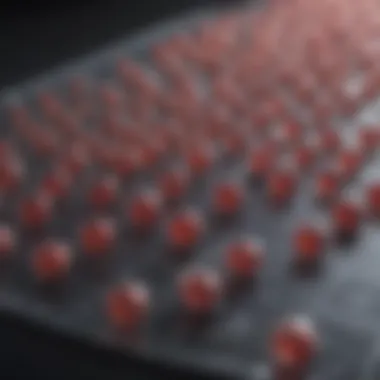Hospital Acquired MRSA: Understanding the Threat


Intro
Methicillin-resistant Staphylococcus aureus (MRSA) poses a significant risk in hospital environments. Understanding its mechanisms of transmission and impact on patient care is crucial for healthcare professionals. This article will explore various dimensions of hospital-acquired MRSA, providing valuable insights that can help improve infection control practices.
Research Overview
Summary of Key Findings
Research indicates that hospital-acquired MRSA infections lead to increased morbidity and mortality rates among patients. The prevalence of MRSA in intensive care units and surgical wards highlights the necessity for effective surveillance and prevention measures. Key findings from various studies emphasize that adherence to infection control protocols can mitigate the risks associated with MRSA effectively.
Methodologies Employed
The research on MRSA has utilized diverse methodologies, including cohort studies, case-control studies, and systematic reviews. Quantitative data from hospital records helps in understanding infection rates and outcomes. Qualitative interviews with healthcare staff provide insights into the challenges of compliance with infection control policies.
In-Depth Analysis
Detailed Examination of Results
A detailed examination of infections reveals that MRSA primarily spreads through direct contact with contaminated surfaces or healthcare workers. Studies show that hand hygiene is a significant factor in controlling MRSA spread. Patients with open wounds or invasive devices are at particularly high risk, thereby necessitating targeted interventions.
Comparison with Previous Studies
Comparative analyses indicate that recent trends in MRSA infections show a decrease in certain regions due to improved infection control measures. However, other studies report a rise in community-associated strains that may complicate hospital scenarios. The understanding of these dynamics is essential for healthcare facilities to adapt and respond proactively.
"Preventing MRSA spread entails a multifaceted strategy that includes education, compliance, and continuous monitoring."
Strong attention to infection prevention practices is essential for healthcare providers. Education programs for both staff and patients can enhance awareness and compliance.
Ending
In summary, understanding and managing hospital-acquired MRSA is integral to enhancing patient safety and healthcare outcomes. Research informs about the patterns of infection, guiding the implementation of effective prevention solutions. As the healthcare landscape evolves, ongoing vigilance against MRSA will remain vital.
Prelims to MRSA
Understanding Methicillin-resistant Staphylococcus aureus (MRSA) is crucial in the landscape of modern healthcare. MRSA represents a strain of Staphylococcus aureus that has developed resistance to methicillin and other beta-lactam antibiotics. This resistance leads to more complicated treatment protocols, often resulting in longer hospital stays, increased medical costs, and heightened patient morbidity. The emergence of such resistant strains highlights the need for effective infection control strategies and a thorough understanding of the epidemiology surrounding hospital-acquired infections.
Definition and Characteristics of MRSA
MRSA is a type of bacteria that is resistant to methicillin, a common antibiotic used to treat staphylococcal infections. The term "MRSA" stands for Methicillin-resistant Staphylococcus aureus, and it falls under the broader category of Staphylococcus infections. Key characteristics of MRSA include its ability to survive on surfaces and the skin, its capacity to cause a range of infections from mild skin issues to more severe conditions such as pneumonia or bloodstream infections, and its increased resistance to treatment options.
MRSA can be categorized into two main types:
- Healthcare-associated MRSA (HA-MRSA): This type occurs in cluster outbreaks among patients in healthcare settings. It is often linked with invasive procedures or devices, such as surgeries and catheters.
- Community-associated MRSA (CA-MRSA): This form is commonly found in healthy individuals and is often spread through close contact in communal settings, such as prisons or gyms.
The genetic makeup of MRSA allows it to evade the immune response, complicating treatment and increasing the risk of severe infections. Infections caused by this bacterium require precise identification and targeted therapies for effective management.
Importance of Understanding Hospital-Acquired Infections
The significance of understanding hospital-acquired MRSA infections cannot be overstated. These infections pose serious threats to patient safety and are often an indicator of the quality of care provided in healthcare settings. By identifying the prevalence and characteristics of MRSA, healthcare professionals can implement more effective infection control measures.
"The prevention of hospital-acquired MRSA infections is a critical component of patient safety initiatives."
Some key points to consider regarding the importance of these infections include:
- Increased Risk for Vulnerable Patients: Patients with weakened immune systems, such as those undergoing chemotherapy or having surgical procedures, are at higher risk for MRSA infections.
- Impact on Healthcare Resources: Treating MRSA infections often requires more resources, including longer hospital stays and more expensive medications.
- Public Health Concerns: Understanding the transmission dynamics of MRSA provides insights into broader public health strategies aimed at controlling antibiotic resistance.
In summary, focusing on MRSA helps to frame the broader discussion on infection prevention in healthcare settings. By educating healthcare professionals and stakeholders about MRSA, it is possible to mitigate risks associated with these infections and improve overall patient outcomes.
Epidemiology of Hospital-Acquired MRSA
Epidemiology plays a crucial role in comprehending hospital-acquired MRSA's impact on public health. Understanding the patterns of infection, transmission rates, and affected populations allows healthcare professionals to implement effective policies for preventing and treating this serious condition. The knowledge gained through epidemiological studies influences everything from public health guidelines to hospital protocols, making it essential for both practitioners and administrative personnel.
Global Prevalence Rates
The prevalence of hospital-acquired MRSA varies significantly across different regions and healthcare settings. Globally, the rates of MRSA show notable variations influenced by several factors such as local infection control practices, antibiotic usage, and the existence of surveillance systems. According to the World Health Organization, prevalence rates can range from as low as 5% to over 40% in certain hospital settings. Specifically, countries with strong infection prevention control measures tend to have lower MRSA rates compared to those with less stringent practices.
Understanding these rates helps in identifying high-risk regions, which is vital for targeted interventions.
Several studies illustrate how certain geographic areas are more affected than others. For example, legislation pertaining to antibiotic use and hospital standards can significantly affect local MRSA prevalence. In general, a robust framework for monitoring and addressing MRSA infections is necessary to improve patient outcomes and reduce mortality rates.
Trends in Hospital Settings
Trends related to hospital-acquired MRSA are continually evolving. Over the past few decades, there has been a noticeable increase in the recognition of MRSA in not just surgical wards but also in intensive care units, long-term care facilities, and outpatient clinics. A few key trends include:
- Increasing resistance: MRSA strains are showing an increase in antibiotic resistance, making treatment more complicated for healthcare providers. This resistance pattern signifies the need for revised treatment protocols and increased surveillance.
- Regional outbreaks: Some hospitals report sporadic outbreaks, particularly during colder months. Tracking these outbreaks through epidemiological methods is essential for containment.
- Focus on prevention measures: Many healthcare settings are investing more in infection prevention programs, recognizing that proactive measures reduce transmission rates significantly. This focus is particularly evident in response to rising pressure from public health organizations and government mandates.
In summary, the epidemiology of hospital-acquired MRSA is not static. It requires consistent updates and adjustments in practices based on newly available data. Through monitoring, analysis, and commitment to best practices, healthcare providers can better manage this persistent issue for improved patient safety.


Transmission Pathways
Understanding the transmission pathways of hospital-acquired MRSA is crucial for developing effective strategies to combat its spread. These pathways encompass how the bacteria move from one host or surface to another, thereby informing infection control measures. They can significantly impact the incidence and prevalence of MRSA infections within healthcare settings. Consequently, the awareness of transmission mechanisms helps healthcare professionals implement targeted interventions that reduce risk.
Patient-to-Patient Transmission
Patient-to-patient transmission refers to the direct spreading of MRSA between individuals in close proximity. Factors such as shared rooms, common areas, or medical procedures can facilitate this process. For example, a patient may acquire MRSA during their hospital stay if they come into contact with an infected person.
Several studies highlight the high risk of transmission in intensive care units. The presence of open wounds and invasive devices increases susceptibility and transmission likelihood. Surveillance and strict adherence to isolation protocols are essential in these environments.
Preventive measures can include:
- Isolation of infected patients to prevent contact with other patients.
- Use of personal protective equipment (PPE) such as gloves and gowns for staff handling MRSA patients.
- Regular screening of patients who have been in contact with known MRSA cases.
Environmental Reservoirs
Environmental reservoirs play a significant role in the transmission dynamics of MRSA. These reservoirs can include surfaces and equipment used in healthcare settings. The bacteria can survive on various surfaces like bed linens, medical devices, and countertops for prolonged periods.
Research indicates that contaminated surfaces contribute to indirect transmission. If a healthcare worker or patient touches a contaminated surface and then their own body, MRSA can enter the body through breaks in the skin or mucous membranes. Regular cleaning and disinfection routines are therefore vital in mitigating this risk.
Key measures to manage environmental risk factors include:
- Regular cleaning and disinfection of high-touch surfaces in patient care areas.
- Use of effective disinfectants that target MRSA.
- Education for staff on proper cleaning protocols and the importance of minimizing cross-contamination.
Role of Healthcare Workers
Healthcare workers are pivotal in the transmission of MRSA, often as vectors between patients and contaminated environments. Their hand hygiene practices, use of PPE, and adherence to protocols affect the bacteria's spread. When healthcare providers neglect proper sanitation or protective measures, the risk of transferring MRSA from patient to patient increases significantly.
Efforts must include:
- Ongoing education and training for healthcare workers on MRSA transmission and prevention strategies.
- Implementation of infection control committees that oversee adherence to guidelines.
- Encouragement of a culture of safety, where staff feel empowered to report lapses in hygiene practices.
"Effective communication and training among healthcare workers can drastically reduce the risk of MRSA transmission in hospital settings."
By addressing patient-to-patient transmission, environmental reservoirs, and the crucial role of healthcare workers, we can create a well-rounded understanding of the transmission pathways for MRSA. This understanding is essential for safeguarding patient health and ensuring effective infection control measures are in place.
Risk Factors for Hospital-Acquired MRSA Infections
Understanding the risk factors for hospital-acquired MRSA infections is essential for effective management and prevention strategies in healthcare settings. MRSA poses a significant threat in hospitals, where vulnerable patients can easily contract infections. Identifying these risk factors allows healthcare providers to implement targeted interventions, reducing the incidence of MRSA and protecting patient health.
Patient-Related Factors
Certain patient-related factors increase the likelihood of acquiring MRSA infections. These include:
- Underlying Health Conditions: Patients with chronic diseases like diabetes, kidney disease, or cancer often have compromised immune systems. This can make them more susceptible to infections.
- Previous Antibiotic Use: Patients who have received antibiotics are at risk of developing antibiotic-resistant infections. This is due, in part, to the disruption of normal flora, allowing resistant bacteria like MRSA to flourish.
- Length of Hospital Stay: Longer hospitalizations correlate with a higher risk of MRSA infections. Extended exposure to the hospital environment increases chances of contact with contaminated surfaces and healthcare workers.
- Surgical Procedures: Patients undergoing surgical interventions are often exposed to invasive devices and surgical wounds, which serve as potential entry points for MRSA.
These factors highlight the need for vigilant screening and personalized care plans to better protect high-risk patients.
Healthcare Environment
The healthcare setting itself plays a crucial role in the transmission of MRSA. Various factors contribute to this risk:
- Hygiene Practices: Inadequate hand hygiene among healthcare staff can facilitate the spread of MRSA. Consistently adhering to handwashing guidelines is paramount to preventing infections.
- Environmental Contamination: Surfaces, equipment, and devices in hospitals can harbor MRSA. Frequent cleaning and disinfection of these areas are necessary to minimize environmental reservoirs.
- Staffing Levels: Insufficient staffing may compromise infection control practices. Higher patient-to-staff ratios can lead to increased workloads, potentially resulting in lapses in infection prevention measures.
- Isolation Protocols: Lack of proper isolation protocols for infected patients can significantly contribute to MRSA transmission. Effective isolation can prevent cross-contamination between patients.
These considerations indicate that a well-structured healthcare environment is essential for mitigating the risks associated with MRSA infections.
By addressing both patient-related and healthcare environment factors, hospitals can develop comprehensive strategies to combat MRSA infections effectively.
Identifying and managing these risk factors is critical for improving patient outcomes and ensuring a safer healthcare environment.
Clinical Manifestations of MRSA Infections
Understanding the clinical manifestations of MRSA infections is crucial for effective diagnosis and treatment. Methicillin-resistant Staphylococcus aureus can present in various forms, influencing patient outcomes and healthcare practices. Recognizing these manifestations can aid in prompt identification, mitigating severe complications and improving patient management.
Skin and Soft Tissue Infections
Skin and soft tissue infections caused by MRSA encompass a broad spectrum of conditions. These infections often manifest as cellulitis, abscesses, or boils. Patients may present with localized redness, swelling, and tenderness. In many instances, the skin may exhibit pus, indicative of an underlying abscess.
- Common signs include:
- Erythema (redness of the skin)
- Swelling
- Warmth to the touch
- Pain at the site of infection
- Pus formation or other drainage
Skin infections can occur following minor trauma, such as cuts or insect bites. They are particularly prevalent in patients with compromised skin integrity, such as those with chronic wounds or dermatitis. Early intervention is key, as untreated infections can progress, leading to more invasive diseases.
The importance of understanding these common presentations lies in their frequency in healthcare settings. Prompt diagnosis through visual assessment and culture testing can help delineate the extent of infection and guide treatment strategy.
Severe Invasive Infections


Severe invasive infections represent a more critical consequence of MRSA. These infections can lead to significant morbidity and mortality if not addressed timely. They generally include conditions like bacteremia, pneumonia, endocarditis, and osteomyelitis.
The clinical features of severe invasive MRSA infections can vary widely and may present as:
- Fever and chills
- Rapid heart rate
- Septic shock in severe cases, characterized by low blood pressure
- Respiratory distress, particularly in pneumonia
- Bone pain in the context of osteomyelitis
"The rapid progression to severe manifestations in vulnerable populations necessitates heightened awareness and swift clinical action."
Patients at heightened risk often include those with underlying health conditions, such as diabetes or chronic lung disease, and those undergoing invasive procedures. Meticulous monitoring and aggressive treatment are indispensable to improve outcomes in these cases.
Diagnosis of MRSA Infections
Diagnosing hospital-acquired MRSA infections is critical for appropriate patient management and the implementation of effective infection control measures. Rapid and accurate diagnosis can significantly affect treatment outcomes and reduce the spread of the bacteria in healthcare settings. Understanding this process not only aids in clinical decision-making but also fosters a safer healthcare environment for all patients.
Culture and Sensitivity Testing
Culture and sensitivity testing remains the gold standard for diagnosing MRSA infections. This method involves taking a sample of the infected tissue or fluid and culturing it in a lab. A few crucial steps define this process:
- Sample Collection: Clinicians must gather samples from the suspected site of infection, ensuring to follow proper protocols to avoid contamination.
- Incubation: The samples are then incubated to allow any bacteria present to grow. MRSA colonies typically emerge if they are present.
- Sensitivity Testing: Once MRSA is cultured, a sensitivity test determines which antibiotics can effectively combat the specific strain. This step is essential for guiding treatment decisions and avoiding ineffective therapies.
Culture and sensitivity testing is vital because results can take 24 to 48 hours. However, these results inform critical immediate decisions regarding therapy choices, preventing unnecessary antibiotic use which can contribute to resistance.
Molecular Methods
Molecular methods for diagnosing MRSA have gained traction as they offer quicker results than traditional culturing. One of the most prevalent techniques is polymerase chain reaction (PCR). This technique detects the presence of MRSA genetic material in a patient’s sample.
Advantages of molecular methods include:
- Speed: Tests can produce results in a few hours, thus allowing for timely initiation of appropriate therapy.
- Sensitivity and Specificity: Molecular tests tend to have higher sensitivity and specificity, reducing the likelihood of false negatives or positives.
- Detection of Carriers: These methods can also identify MRSA carriers, helping to implement isolation measures before the onset of infection in other patients.
By combining molecular testing with traditional culture methods, clinicians can enhance the accuracy and speed of MRSA diagnosis, ultimately improving patient outcomes and bolstering infection control protocols.
"Accurate and rapid diagnosis forms the backbone of effective MRSA management and infection control within hospital settings."
Treatment Protocols for Hospital-Acquired MRSA
The treatment of hospital-acquired Methicillin-resistant Staphylococcus aureus (MRSA) is essential in managing infections effectively. Its significance lies in the challenges MRSA presents in healthcare settings. Timely and appropriate treatment protocols are vital to improving patient outcomes and minimizing the risk of spread within facilities. Given the growing resistance of MRSA to many antibiotics, understanding the available treatment options and the accompanying challenges is necessary.
Antibiotic Options
When it comes to treating hospital-acquired MRSA, choices of antibiotics are more limited compared to other infections. However, several options are still effective in combatting these resistant strains. Common antibiotics used include:
- Vancomycin: This remains the first-line treatment for serious MRSA infections. It is effective against various strains and is usually administered intravenously in hospital settings.
- Daptomycin: This agent is often used for skin and soft tissue infections or bacteremia caused by MRSA. Its unique mechanism of action helps disrupt bacterial cell membranes.
- Linezolid: An alternative for patients who might be allergic to or intolerant of vancomycin. It can be used for pneumonia and skin infections caused by MRSA.
- Ceftaroline: This is a newer cephalosporin antibiotic that shows activity against MRSA, particularly useful for treating community-acquired MRSA with severe symptoms.
Selecting the right antibiotic often involves considering the patient’s individual condition and history. The necessity for culture and sensitivity testing prior to starting treatment cannot be overstated. This helps identify the most effective antibiotic and also reveals any additional resistances present.
Treatment Challenges
Despite the available treatment options, challenges persist in managing MRSA infections. Some of these challenges include:
- Increased Resistance: As MRSA adapts to antibiotics, new strains may evolve. This affects treatment efficacy and may necessitate the use of more potent or combination therapies, which can lead to increased costs and side effects.
- Adverse Effects: Antibiotics like vancomycin can cause nephrotoxicity and other side effects. Monitoring for these is crucial during treatment, particularly in patients with existing kidney issues.
- Inadequate Response: Patients with severe infections may experience inadequate response to standard treatment protocols. This situation often means escalation to broader-spectrum antibiotics, which can increase the risk of developing secondary infections.
- Length of Treatment: The duration of antibiotic treatment often extends. Prolonged therapy can complicate management and increase the likelihood of complications.
"Appropriate management requires a multidisciplinary approach involving physicians, pharmacists, and infection control specialists."
It is essential for healthcare facilities to maintain strict protocols for monitoring and modifying treatment to adapt to the evolving landscape of MRSA. Adjusting treatment protocols according to real-time clinical data is crucial to tackling the challenges posed by MRSA effectively.
Preventive Measures in Hospital Settings
Preventive measures in hospital settings are crucial to mitigate the risk of hospital-acquired MRSA infections. These actions not only protect patients but also staff and visitors. Given the resilience of MRSA and its ability to spread rapidly in healthcare environments, diligent adherence to preventive strategies is essential.
Infection Control Protocols
Infection control protocols provide a structured approach to reducing MRSA transmission. These protocols involve several critical elements:
- Standard Precautions: These are basic infection prevention practices that assume all patients might be infected. Staff must wear gloves and gowns when handling potentially contaminated materials.
- Isolation Measures: Patients known to be colonized or infected with MRSA should be placed in isolation to prevent their infection from spreading to others.
- Regular Screening: Hospitals should implement routine screening for MRSA in high-risk populations, such as surgical patients, to identify carriers and start precautions early.
- Environmental Cleaning: Regular and thorough cleaning of hospital environments, including high-touch surfaces, is essential to eliminate MRSA from surroundings.
Attention to these protocols reduces infection rates significantly. Hospitals that excel in these measures see marked improvements in patient outcomes.
Hand Hygiene Practices
Hand hygiene is a fundamental aspect of infection control. Proper handwashing can prevent the transmission of MRSA in healthcare settings. Effective hand hygiene practices include:
- Alcohol-Based Hand Sanitizers: These should be used when hands are not visibly dirty, as they are effective against most pathogens, including MRSA.
- Soap and Water: Hands should be washed with soap and water when they are visibly soiled or after caring for a patient with known MRSA.
- Education and Reminders: Regular training and visual prompts in staff areas can reinforce the importance of proper hand hygiene.
"Hand hygiene is the simplest, most effective method for preventing the spread of infections in healthcare settings."
Incorporating and monitoring adherence to hand hygiene protocols fosters a culture of safety and vigilance among healthcare workers. Ultimately, these preventive measures can lead to a significant decline in MRSA incidence in hospitals.


Surveillance and Reporting of MRSA Infections
Surveillance and reporting of MRSA infections is a critical component in managing hospital-acquired infections. This systematic approach aims to monitor, analyze, and report data on MRSA cases within healthcare settings. By doing so, healthcare facilities can understand the prevalence and trends of MRSA in real time, allowing for timely interventions. The effectiveness of infection control strategies often hinges on the collection and interpretation of quality data regarding MRSA infections.
Importance of Surveillance Programs
Surveillance programs hold great significance for several reasons. Firstly, they enable healthcare providers to identify outbreaks and understand the patterns of MRSA transmission. Tracking infection rates can lead to early detection of potential outbreaks, which is essential for protecting vulnerable patients. Secondly, these programs help in evaluating the effectiveness of existing infection control measures. Without diligent tracking, it would be difficult to assess whether the interventions put into place are indeed working.
Moreover, systematic reporting of MRSA cases influences public health policies. Healthcare administrators and policymakers require reliable data to allocate resources effectively. Infection prevention and control policies should be guided by accurate surveillance data to create targeted strategies against MRSA. Lastly, increased transparency in infection rates fosters accountability amongst healthcare institutions.
Data Analysis and Impact on Policy
The analysis of MRSA infection data leads to meaningful insights that can impact healthcare policy significantly. Analyzing trends in MRSA infections allows stakeholders to identify risk factors and high-incidence areas within hospitals. This data can help pinpoint the causes of transmissions and develop tailored interventions.
Furthermore, comprehensive data analysis informs decision-making at all levels of healthcare governance. For example, data indicating a rise in MRSA cases could prompt stricter guidelines for hygiene and equipment sterilization. Such data might show that particular wards have higher infection rates than others, leading to focused investigation and resource allocation.
"Effective data analysis can provide a roadmap for improving patient safety and reducing infection rates in healthcare settings."
Legislation and Guidelines Related to MRSA
Understanding the legislation and guidelines surrounding Methicillin-resistant Staphylococcus aureus (MRSA) is crucial for effective infection control in healthcare settings. Regulatory measures shape how facilities operate and deal with potential MRSA outbreaks. With the rising prevalence of hospital-acquired MRSA, having a robust legal framework helps to protect both patients and healthcare workers. These regulations often stem from broader public health initiatives aimed at minimizing infection rates. They ensure that hospitals implement strategies that are evidence-based and prioritize safety in patient care.
Furthermore, guidelines offer standardized protocols that healthcare facilities should follow. This not only aids in maintaining compliance but also enhances the quality of care provided to patients. Emphasizing MRSA in healthcare regulations reflects an ongoing commitment to improve patient outcomes in an environment that is increasingly vulnerable to infectious diseases.
Healthcare Regulations
Healthcare regulations related to MRSA typically encompass a variety of aspects, including mandatory reporting of hospital-acquired infections, infection control measures, and guidelines for antibiotic stewardship. These regulations ensure that healthcare institutions maintain high standards of hygiene and patient management. Compliance with these rules decreases the transmission rates of MRSA in hospitals.
For instance, the Centers for Disease Control and Prevention (CDC) and the World Health Organization (WHO) publish guidelines that detail necessary precautions to curb the spread of MRSA. These include recommendations for patient screening, isolation protocols, and proper sanitation practices. The failure to adhere to these regulations can lead to penalties, loss of accreditation, and increased liability for healthcare providers.
Best Practice Guidelines for Healthcare Providers
Best practice guidelines for healthcare providers specifically focus on the handling of MRSA cases and prevention strategies. These guidelines are supported by scientific research and are designed to be followed for optimal patient care. They include key practices such as:
- Rigorous Hand Hygiene: Encouraging healthcare providers to wash hands thoroughly before and after patient interactions.
- Use of Personal Protective Equipment (PPE): Ensuring that appropriate PPE is used, especially when dealing with open wounds or patients in isolation.
- Environment Sanitization: Regularly disinfecting surfaces that are commonly touched in patient care areas to minimize the risk of cross-contamination.
Additionally, ongoing education for healthcare professionals about MRSA management is an essential component of these guidelines. This includes training on recognizing early signs of MRSA infections and understanding treatment options.
"Implementing effective guidelines can significantly reduce the incidence of MRSA infections in a healthcare setting."
Overall, legislation and best practice guidelines are fundamental in creating an environment where MRSA is controlled, and its impact on patient care is minimized.
Future Directions in MRSA Research
Research into Methicillin-resistant Staphylococcus aureus (MRSA) is crucial because this bacterium poses significant threats in healthcare environments. Current treatments face many challenges, making it essential to explore new directions in research. These efforts can lead to more effective strategies for managing and preventing MRSA infections. Focusing on emerging treatments and vaccination efforts will enhance the understanding of MRSA and its possible eradication or management.
Emerging Treatments
Emerging treatments are one of the most promising avenues in MRSA research. Researchers are investigating novel antibiotics that may overcome MRSA's resistance mechanisms. For instance, compounds like ceftaroline and dalbavancin have shown effectiveness against MRSA in clinical settings. Additionally, alternative therapies such as bacteriophage therapy harness viruses that infect bacteria. This method shows promise in targeting resistant bacteria without harming human cells.
Moreover, immunotherapy is gaining attention. This approach aims to boost the body's immune response against MRSA. Studies are showing potential in monoclonal antibodies that specifically target MRSA pathogens. By engaging the immune system, these therapies can aid in reducing infection rates and severity.
Some researchers are also looking into the role of probiotics in managing MRSA colonization. Using beneficial bacteria may prevent MRSA from establishing itself in patients, thus lowering infection rates.
Vaccination Efforts
Vaccination efforts are another critical area of focus in the fight against MRSA. The development of a effective vaccine for MRSA remains a challenge due to its high genetic variability and the ability of the bacteria to evade the immune response. However, ongoing research is exploring various vaccine candidates targeting different aspects of MRSA biology.
Currently, several vaccine candidates are in various stages of clinical trials. Some aim to induce an immune response against MRSA toxins, which can prevent severe disease outcomes. Other initiatives are looking at polysaccharide vaccines targeting capsule components of MRSA.
An effective MRSA vaccine could significantly reduce infection incidence in hospitals, benefiting particularly vulnerable populations such as surgical patients and those with weakened immune systems.
In summary, focusing on emerging treatments and vaccination efforts forms the backbone of future MRSA research. Addressing these areas is essential for advancing healthcare practices and improving patient outcomes.
"Investing in research for emerging treatments and vaccination strategies against MRSA can reshape the landscape of infection control in healthcare settings."
Continuous efforts in these domains are crucial to overcoming the challenges MRSA presents in hospital environments. By fostering innovation and optimizing treatment and prevention strategies, the healthcare industry can combat this resilient pathogen effectively.
Culmination
The conclusion of this article addresses the significant implications of hospital-acquired MRSA, reinforcing the necessity for persistent awareness and robust preventive measures. The emphasis on comprehension of antibiotic resistance, particularly in the context of MRSA, is paramount. As healthcare facilities are prone to outbreaks, the burden of this infection can severely impact patient outcomes. Therefore, integral to addressing this challenge is stringent infection control practices and thorough surveillance.
Summary of Key Points
Throughout the article, we discussed several crucial aspects regarding hospital-acquired MRSA:
- Epidemiology: Hospital-acquired MRSA remains a prevalent issue, necessitating understanding and proactive measures in healthcare environments.
- Transmission: Understanding how MRSA spreads, whether through direct contact or environmental reservoirs, is essential for implementing control strategies.
- Risk Factors: Various factors contribute to individual vulnerability, including patient health status and hospital practices.
- Treatment Challenges: The presence of antibiotic resistance complicates treatment protocols, making it essential to explore diverse therapeutic options.
- Prevention and Surveillance: Systematic infection control measures and ongoing data collection are crucial in mitigating MRSA incidents in hospitals.
The Importance of Ongoing Research and Awareness
Continued research into MRSA is vital for several reasons. First, understanding the genetic mutations that contribute to antibiotic resistance can help devise new treatment options. Also, healthcare professionals benefit from updated knowledge about best practices in infection control, which can evolve based on recent findings.
Furthermore, public health initiatives aimed at increasing awareness of MRSA can foster better patient engagement. Patients educated about hygiene and infection risks can contribute to reducing transmission rates, benefiting all hospital visitors.
Ongoing vigilance in both research and practice ensures that healthcare providers remain equipped to tackle this persistent infection. The drawn-out struggle against MRSA highlights the need for sustained resources and efforts to safeguard public health.















